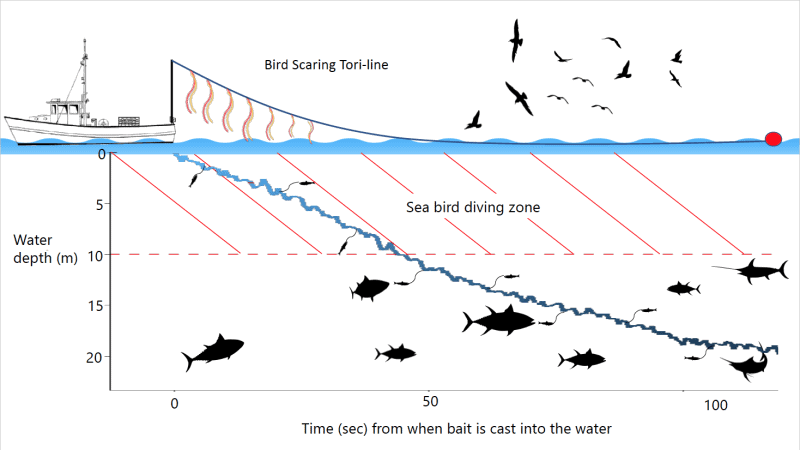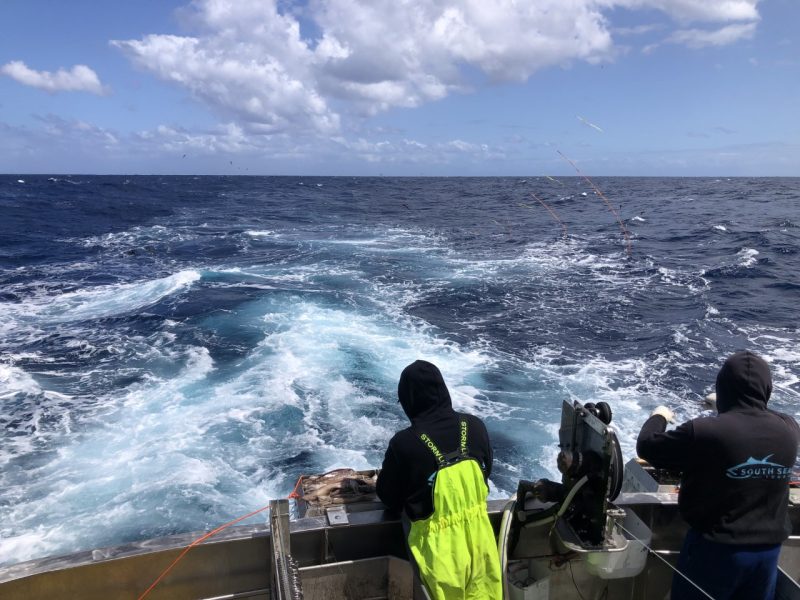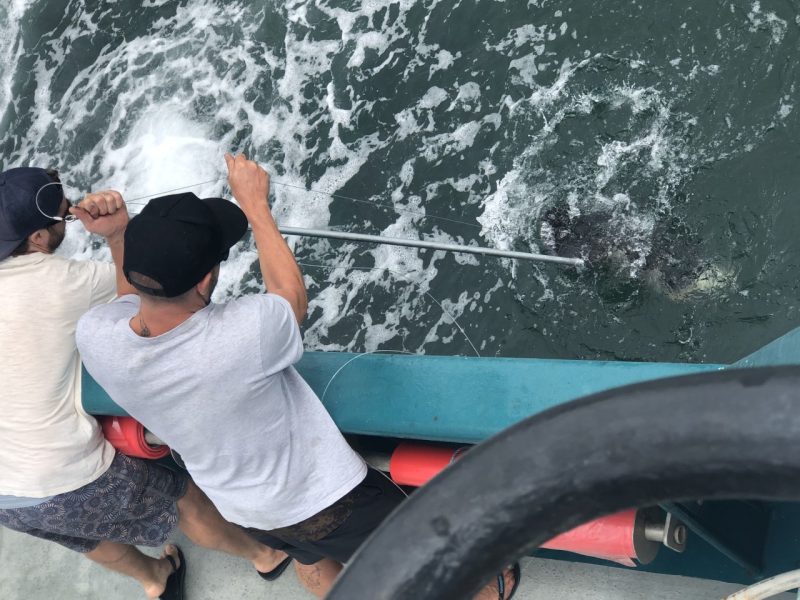World-leading research to better manage wildlife interactions
Tuna Australia is uncovering how to combine existing fishing tools to reduce interactions with scavenging seabirds as part of world-leading research.
“We’ve seen great initial results that validate our thinking about new approaches to seabird mitigation,” said Tuna Australia CEO David Ellis.
“This world-leading research will provide vital information for commercial fishers in Australia and abroad.”
Measuring sink rates
Fishers operating in the Eastern Tuna and Billfish Fishery are required to use bird scaring lines known as tori lines—a proven method for minimising seabird bycatch.
Mitigation is most effective when used with other measures such as line weighting to ensure that hooks sink more quickly.
The research aims to determine how fishers can use such measures in diverse environmental conditions to get baits below the sea bird feeding zone before the tori line bird scaring device ends.

The trials explore how fishers can use different techniques to get baits below the setting zone before the tori line ends.
Tuna Australia is conducting two at-sea trials - one from Ulladulla and the other from Nelson Bay.
"We are using time-depth recorders attached to fishing gear to understand the sink rates of fishing gear,” said Tuna Australia Program Manager Phil Ravanello.
“These are relative to vessel speed, the rate at which line leaves the boat, in-water current speed and direction, line weighting, and even how the bait is hooked.”
“We can measure and change these variables to differ sinking profiles.”
Tuna Australia members operate in a closely monitored and highly regulated industry with strict limits and rules to reduce interactions with various protected species.
“This research project, funded by the Fisheries Research and Development Corporation, will pinpoint further opportunities to reduce the already low rate of interactions with seabirds and other wildlife,” said Ravanello.

Surprising observations
The first at-sea trial was conducted on the FV Markana in February 2023.
A surprising observation for the boat owner and skipper Paul Lavalle was that the longline sink rate was not what he expected.
“Our fishing techniques have always been consistent based on sea or climate conditions,” he said.
“Having the measuring equipment on board has blown away any assumptions I had about how deep our gear was setting.”
Initial findings show the longline is sinking 30 percent less than Lavalle assumed.
“Now we know this, we can make changes to ensure our gear gets down to where the fish are,” he said.
Collaborating to achieve success
Tuna Australia is working with honours and PhD students from the University of the Sunshine Coast to build statistical models to analyse the data.
“The models will compare the sink rates of standard fishing gear used by industry with new mitigation concepts such as weighted hooks and reusable hook covers,” said University of the Sunshine Coast Associate Professor in Animal Ecology, Dr. Kylie Scales.
“Results will be useful for understanding how quickly and efficiently the mitigation technologies move the bait below the average dive depths of albatrosses and shearwaters in Australian conditions.”
Other collaborators on the project include the Australian Fisheries Management Authority, Australian Bureau of Agricultural and Resource Economics and Sciences, and Humane Society International.

Industry leading the way
Wildlife interactions are a global barrier to fisheries sustainability.
“Reducing the likelihood of unwanted interactions with marine wildlife is an important goal for industry and managers, particularly for threatened, endangered, and protected species,” said Scales.
“Bycatch remains a threat to species of conservation concern such as seabirds, turtles, and sharks.”
“Tuna Australia and the Eastern Tuna and Billfish Fishery are leading a path towards more sustainable and less impactful fisheries through trialling new gear and techniques to reduce unwanted wildlife interactions,” she said.
The research results will highlight how industry can change how it sets gear, said Ellis.
“It will deliver sound outcomes that will benefit threatened and migratory species here and abroad."
This work complements Tuna Australia's research to test new and improved wildlife mitigation technologies that enhance crew safety.
“These complementary research efforts are putting safety and wildlife protection at the forefront of daily fishing operations,” said Ellis.
“Investing in industry research and collaborating with industry partners ensures that Tuna Australia members are well informed about the scientifically tested and proven options available to mitigate wildlife interactions.”
The next step to manage wildlife interactions is to research and develop a reporting process that identifies wildlife interactions to a species level and where and when the interaction occurred.
“Once we know this information, we can explore specific mitigation options which will influence how threatened and migratory species are managed domestically and internationally,” said Ellis.